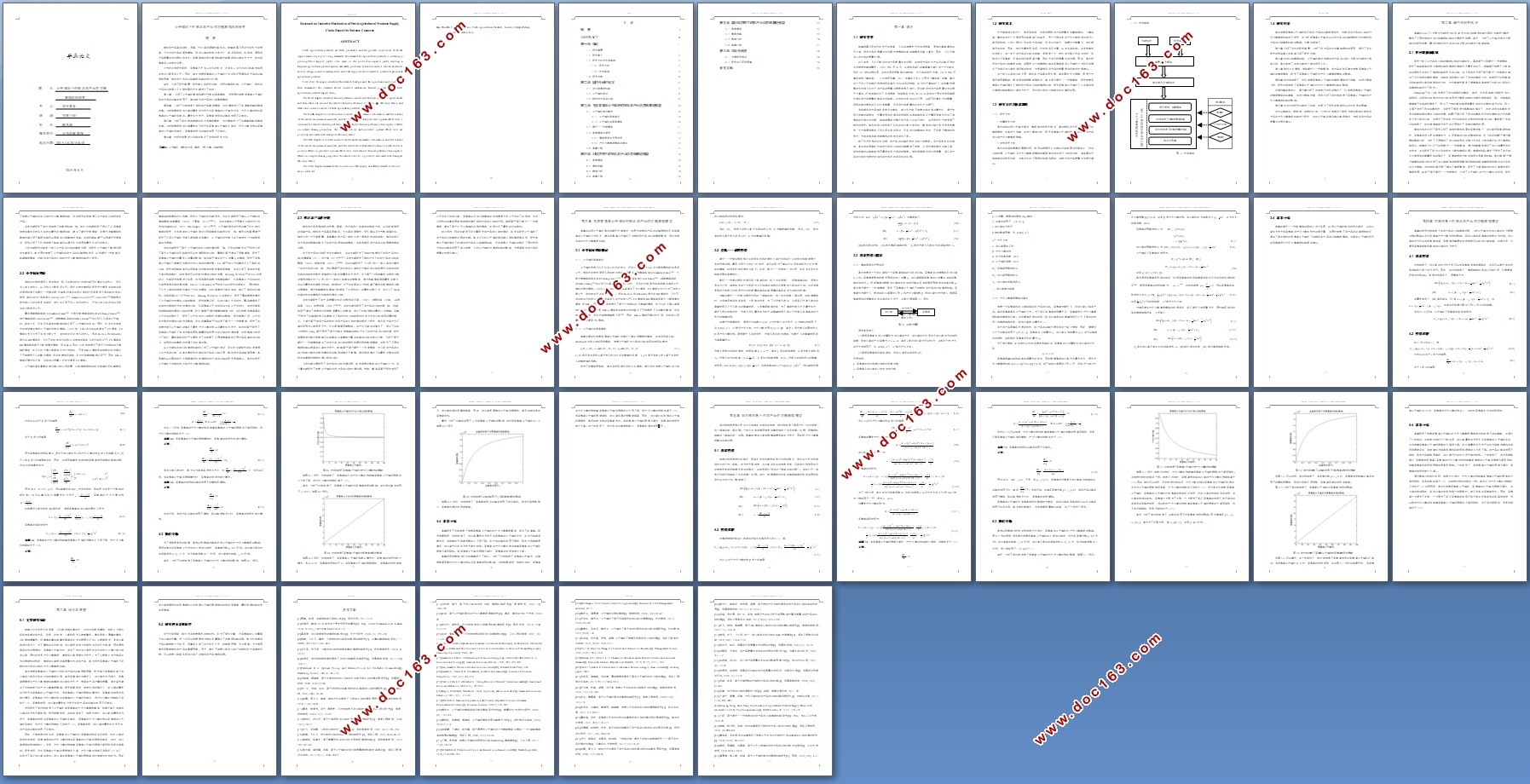公平偏好下的鲜活农产品供应链激励机制研究

1.无需注册登录,支付后按照提示操作即可获取该资料.
2.资料以网页介绍的为准,下载后不会有水印.资料仅供学习参考之用.
密 惠 保
公平偏好下的鲜活农产品供应链激励机制研究(任务书,开题报告,外文翻译,论文16000字)
摘 要
鲜活农产品具有新鲜、易腐、生长具有周期性等特点。随着我国人民的生活水平的提高,人们对农产品的需求增加,而供应商的利润空间过小,甚至零利润、负利润,导致农产品质量安全问题时有发生。零售商如何设计激励机制才能激励供应商努力生产,成为零售商关心的热点问题。
行为经济学研究表明,零售商不光关心自己的利益,还会关心自己与供应链其他成员的利益分配是否公平。因此,本文考虑零售商的公平偏好行为的特征因素和农产品的运输损耗因素,鲜活农产品供应链激励机制的设计问题。
首先,介绍了研究背景、研究意义和研究内容;进而对激励机制、公平偏好、鲜活农产品供应链等三个方面对国内外文献进行了综述;
第三章,介绍了公平偏好模型和委托代理的基本模型,进而同时考虑零售商公平偏好和农产品的运输有效因子,建立鲜活农产品供应链激励模型;
第四章,分析了对称信息下鲜活农产品激励模型,并对模型进行了均衡解求解和数值仿真。分析结果表明供应商的最优努力水平与零售商的公平偏好无关,产出分享比例与零售商的公平偏好负相关。最优努力水平、零售商效用与运输有效因子正相关。 [资料来源:http://www.THINK58.com]
第五章,分析了非对称信息鲜活农产品激励模型,并对模型进行了均衡解求解和数值仿真。分析结果表明供应商最优努力水平与零售商公平偏好正相关,产出分享比例与零售商的公平偏好负相关。零售商效用与运输有效因子正相关。
第六章,对研究成果进行总结并指出了未来的研究方向。
关键字:公平偏好 鲜活农产品 激励 产出分享 运输损耗
Research on Incentive Mechanism of Fresh Agricultural Products Supply Chain Based On Fairness Concerns
ABSTRACT
Fresh agricultural products are fresh, perishable and the growth is periodical. With the improvement of people's living standards, the demand for agricultural products is increasingly growing.While supplies’ profit is too small, or zero profit even negative profit, resulting in frequent agricultural product quality and safety problems. It has become hot issue that retailers how to design incentive mechanism to motivate suppliers strive harder to produce high-quality agricultural products.
First of all, this paper introduces the research background, the significance and content and then summarizes the literature about incentive mechanism, fairness preference and fresh agricultural products supply chain; [资料来源:http://think58.com]
The third chapter introduces fairness preference model and the basic principal - agent model, and then takes into account the retailer’s fairness preference and transport efficiency factor, and establishes incentive model of fresh agricultural products supply chain;
The fourth chapter solves the incentive model under symmetric information and the solution of the model are numerical analyzed, and the results show that provider’s optimal effort level is irrelevant for retailer’s fairness preference. And retailer’s fairness preference has negative effects on output sharing proportion. The retailer’s utility and provider’s optimal effort level are positively associated with transport efficiency factor.
The fifth chapter solves the incentive model under asymmetric information and the solution of the model are numerical analyzed, and the results show that retailer’s fairness preference has positive effects on provider’s optimal effort level. And retailer’s fairness preference has negative effects on output sharing proportion.The retailer’s utility is positively associated with transport efficiency factor.
[资料来源:THINK58.com]
The sixth chapter summarizes the conclusions of this paper, and future research directions are pointed out.
Key Words: Fairness Concerns; Fresh Agricultural Products ; Incentive;Output Share;
Transportation Loss;
[来源:http://think58.com]

目 录
摘 要 I
ABSTRACT II
第一章 绪论 1
1.1 研究背景 1
1.2 研究意义 2
1.3 研究方法及技术路线 2
1.3.1 研究方法 2
1.3.2 技术路线 3
1.4 研究内容 4
第二章 国内外研究现状 5
2.1 供应链激励机制 5
2.2 公平偏好理论 6
2.3 鲜活农产品供应链 8
第三章 考虑零售商公平偏好的鲜活农产品供应链激励模型 10
3.1 公平偏好理论概述 10
3.1.1 公平偏好基本理论 10
3.1.2 公平偏好的基本模型 10 [来源:http://think58.com]
3.2 委托——代理模型 11
3.3 基本模型与假设 12
3.3.1 模型假设与符号说明 12
3.3.2 产出分享激励模型的建立 13
3.4 本章小结 15
第四章 对称信息下的鲜活农产品供应链激励模型 16
4.1 基本模型 16
4.2 模型求解 16
4.3 数值分析 18
4.4 本章小结 20
第五章 非对称信息下的农产品供应链激励模型 22
5.1 基本模型 22
5.2 模型求解 22
5.3 数值分析 24
5.4 本章小结 27
第六章 结论与展望 28
6.1 主要研究结论 28
6.2 研究的不足和展望 29
参考文献 30 [资料来源:http://think58.com]
